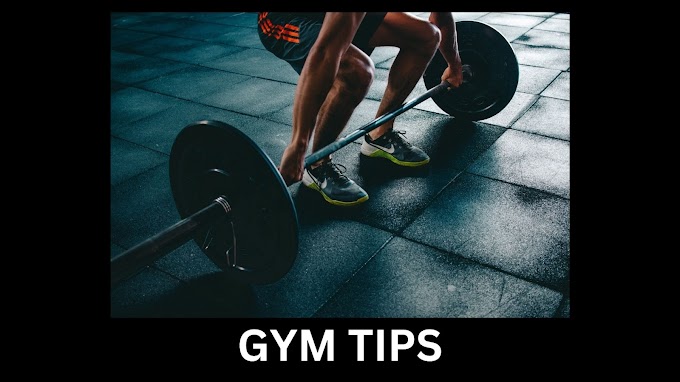10 Golden gym rules and useful gym exercises to start for
beginners
Think about next summer
at a good time! That's why many men naturally go to the gym in the winter
season.
When your stress at work becomes overwhelming, and you often
feel frustrated, you should do something about gym activities. If you are
looking for the golden rules in the gym, then you’re at the right blog post.
Let’s start…
What is the golden rule in the gym?
Principle 1: No one likes to use sweaty gear, so never forget your towel and
then clean the kit with the disinfectant provided.
Principle 2: Leave your cell phone in
the locker room! In a fitness studio, people train and don’t make phone calls
or mess around with the internet.
Rule 3: As a gentleman gym fan, create a
nice atmosphere in the gym area, say hello and offer your help when needed.
Rule 4: Do only one exercise at a time. Blocking multiple machines or
weights at the same time is highly unnecessary for other trainees.
Rule 5: Always keep your eyes on
yourself! No matter how attractive or impressive the people around you are,
don’t stare at a woman or a man. Better focus on your training.
Rule 6: Music inspires! But use headphones and ensure you don’t disturb
anyone with the volume.
Rule 7: If you need
clarification on the equipment, always check with the staff. A wrong workout
can do a lot of damage - especially to your health.
Rule 8: Don’t let the
conversation get in the way of your workout or interrupt other people. Before
or after, of course, there’s nothing wrong with a little chat - as long as no
one is upset.
Rule 9: Don’t use the shower area as your bath - you shave and sing at
home!
Principle 10: While proper
grooming and deodorant after training and showering are essential, you should
be mindful of others. Spraying deodorant in your armpits for two minutes is
inappropriate!
Now nothing should stand in the way of
training and achieving your goals. Enjoy yourself!
Also Read: What are the tips for gym beginners to workout in 2023
How do I start an exercise program?
ورزش کیسے شروع کی جائے
You’ve decided it’s time to start exercising, and you’ve taken
the first step toward a new and better body and mind. It’s the best time
to visist the nearby gym.
“Exercise is
everything!” says Michael R. Bracco, committee chair of the American College of
Sports Medicine. “Exercise can literally cure disease as well as some forms of
heart disease. Numerous exercise methods have been used to help people avoid or
recover from certain forms of cancer. Fitness helps people with arthritis.
Exercise helps people prevent or treat depression.”
And there’s no arguing that exercise can help most people lose
weight and feel healthier.
Of course, there’s a catch: You must be moving and keeping up to
reap the benefits. This doesn’t necessarily mean you have to go through a
rigorous, time-consuming regimen at the gym - although there are certainly
benefits to doing so. However, the truth is that the rewards come after the
work is done.
“Any increase in physical activity will improve weight loss and
muscle gain,” said Rita Redberg, chair of the American Heart Association’s
Scientific Advisory Board.
Exercise options abound, including running, dancing, swimming,
biking — you can even do it at home, Redberg says. The most important thing is
choosing the activities you enjoy the most. This increases the chances of the
exercise session becoming a habit.
How much exercise should you do?
To maintain your performance level, it is recommended to be
physically active for at least 30 minutes 2 to 3 days a week. For those not
currently doing any sport, it is already linked to muscle building and weight
loss. If you have been training for a while and want to increase, you should
prepare 4 to 5 times weekly.
“If you train less, you’ll still see benefits,” says Redberg.
“It's not that you should not perform something if you don't contain 30-35
minutes per day. Because you'll definitely see the benefits even if you only
exercise 5 or 10 minutes more than that.”
Ready to get started?
Health and fitness experts helped us put together this
beginner’s guide, including standard exercise definitions, sample workouts, and
home exercise equipment recommendations.
To measure the intensity of your training, you can check your
heart rate or pulse during physical activity. It should be within the target
range during different intensities.
The target heart rate should be 50% to 70% of the maximum heart
rate at moderate intensity.
Here you go
The first step in any exercise routine is assessing your fitness
for today's chosen exercise. We all have good and bad days. Whenever someone
with a severe medical condition starts a new exercise program, they should
consult a doctor first. Men over 45 and women over 55 should also be examined
by a doctor once a year, Dr. Cedric Bryant, chief physiologist of the American
Council on Exercise.
Regardless of physical condition, however, you can generally
train in a preferred manner.
"I can't consider of any health problem that would be poorer
by the correct kind of practice and exercise,"
says Dr. Medical Stephanie Sigrist, an orthopedic surgeon in private practice.
After self-assessing your fitness, you can set training goals.
“Make sure the goals are clear, specific and most importantly
realistic,” says Sel Fakira, a New York-based exercise physiologist and owner
of Fit5 Fitness. Regardless of goals and fitness, anyone starting a new
exercise program should take precautions to avoid injury.
“Start slow and go
slow,” advises Bryant. He says many beginners make the mistake of starting too
aggressively, giving up too soon when tired or even injured at the end of the
workout. Some become discouraged because they believe that intense training
produces immediate results.
“Typically, if people train too hard too early in a program,
they don't stick with it for long,” says Bryant. "If you really want to
develop new habits, take it slow for the first few sessions."
Definitions of fitness
Even experienced athletes sometimes need clarification about
what certain fitness terms mean. Here are some definitions of words and phrases
you may encounter:
Cardio exercise / Cardio activity
These exercises are strenuous enough to increase breathing and
heart rate temporarily. Running, biking, walking, swimming and dancing or Zumba
fall into this category. The maximum heart rate that should be achieved
during exercise depends on the person’s age. An estimate of a person's
age-related maximum heart rate can be obtained by subtracting the person’s age
from 220.
Flexibility training or stretching
This type of training improves the range of motion of the
joints. Aging and inactivity cause muscles, tendons, and ligaments to shorten
over time. However, contrary to popular belief, stretching and warming up are
not synonymous. Overstretching cold muscles and joints can lead to injury and
overstretching.
Strength or weight
training
This type of exercise aims to improve muscle strength and
function. Specific exercises are performed to strengthen each muscle group.
Weightlifting and training with stretchy resistance bands (such as our Strive
Fitness Bands and Loops) are examples of strength training and bodyweight
exercises, such as push-ups or sit-ups, where you train with only your body
weight.
Seats and representatives
These terms are commonly used for the number of strength
training exercises and refer to repeating the same activity multiple times. For
example, you can do 10 "reps” on the bench press, rest for a few moments,
and then do another “set" of 10 more reps.
Warm-up
Warm-up is preparing your body for exercise and the working of
routine. The body can be warmed up with gentle movements such as slow cycling
or rowing on a rowing machine.
Movement increases blood flow, which warms the muscles and
joints. “Think of it as a lubricant for the body," explains Bryant.
Doing a little light stretching at the end of your "warm-up."
Cool-down
This is a less strenuous phase to cool down the body after a
more intense part of the workout. For example, after running on the treadmill,
you can jog for a few minutes at a slower pace and lean until your breathing
and heart rate slow down. Stretching is often part of the cool-down period.
Training example for beginners
Before you begin your fitness program, it’s essential to warm up
and then do some light stretching. Save most stretches for post-workout when
your muscles are warm.
Once you’re warmed up, experts recommend three types of exercise
for total body fitness: cardiovascular activity, strength conditioning, and
flexibility training. It doesn’t have to be done all at once or in one training
session, but regularly training all areas leads to balanced fitness.
Cardiovascular activity/cardio
Start with cardio, like cycling or running on the treadmill,
four to five times a week for 20 to 30 minutes, says Bryant. To ensure you're
at your best, try the "Speaking Test”: Make sure you can speak without too
much effort. However, you're not working hard enough if you can sing along
easily.
Force conditioning
Start with a series of exercises targeting each major muscle group.
Bryant recommends using a weight that allows you to perform the exercise eight
to twelve times in one set. If you can train with heavier weights, gradually
increase the weight, number of repetitions, or number of sets.
To get maximum benefits, you should strength train at least
twice a week but never train the same body part/muscles two days in a row so
they can rest and grow.
Flexibility training
The American College of Exercise recommends doing slow, steady
static stretches three to seven days a week. Each exercise should last 10 to 30
seconds.
To learn how to perform specific exercises, consider hiring a
personal trainer for a session or two or take advantage of the classes
available at the gym.
Home exercise equipment
Fitness training is only sometimes done in the gym. You can
train from the comfort of your home and achieve goals with your body weight,
such as squats, lunges, push-ups, and sit-ups. Of course, you can also invest
in your equipment to increase your strength and endurance.
Popular Exercises at Home بہترین ورزشیں
Treadmill
Braco says this equipment is excellent for cardiovascular
exercise. He recommends running at a low intensity for 30 minutes and doing the
talk test. Adjust intensity, incline and/or time to suit your needs.
Free weight
Barbells and dumbbells are particularly popular in the strength
equipment category. Dumbbells are recommended for beginners. Fichera recommends
purchasing an (adjustable) dumbbell set that can be adjusted in increments.
Other power equipment
These include kettlebells and elastic bands. Resistance bands
are perfect for beginners, especially since they come with instructions, says
Fakira.
Exercise ball
If you enjoy working out with an exercise ball, this can make
for a great workout. Braco suggests training in front of a mirror to improve
form further or having someone else watch you and give you tips. The exercise
ball is otherwise very versatile and highly suitable for training at home.

.jpg)
.jpg)
.jpg)
.jpg)

.jpg)

.jpg)